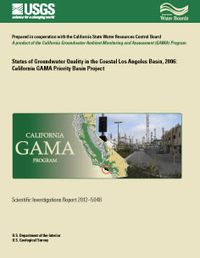Groundwater quality in the approximately 860-square-mile (2,227-square-kilometer) Coastal Los Angeles Basin study unit (CLAB) was investigated as part of the Priority Basin Project of the Groundwater Ambient Monitoring and Assessment (GAMA) Program. The study area is located in southern California in Los Angeles and Orange Counties. The GAMA Priority Basin Project is being conducted by the California State Water Resources Control Board in collaboration with the U.S. Geological Survey (USGS) and the Lawrence Livermore National Laboratory. The GAMA CLAB study was designed to provide a spatially unbiased assessment of the quality of untreated (raw) groundwater in the primary aquifer system. The assessment is based on water-quality and ancillary data collected in 2006 by the USGS from 69 wells and on water-quality data from the California Department of Public Health (CDPH) database. The primary aquifer system was defined by the depth interval of the wells listed in the CDPH database for the CLAB study unit. The quality of groundwater in the primary aquifer system may be different from that in the shallower or deeper water-bearing zones; shallow groundwater may be more vulnerable to surficial contamination. This study assesses the status of the current quality of the groundwater resource by using data from samples analyzed for volatile organic compounds (VOCs), pesticides, and naturally occurring inorganic constituents, such as major ions and trace elements. This status assessment is intended to characterize the quality of groundwater resources in the primary aquifer system of the CLAB study unit, not the treated drinking water delivered to consumers by water purveyors. Relative-concentrations (sample concentration divided by the health- or aesthetic-based benchmark concentration) were used for evaluating groundwater quality for those constituents that have Federal and (or) California regulatory or non-regulatory benchmarks for drinking-water quality. A relative-concentration greater than (>) 1.0 indicates a concentration greater than a benchmark, and a relative-concentration less than or equal to (≤) 1.0 indicates a concentration equal to or less than a benchmark. Relative-concentrations of organic and special-interest constituents [perchlorate, N-nitrosodimethylamine (NDMA), 1,2,3-trichloropropane (1,2,3-TCP), and 1,4-dioxane] were classified as "high" (relative-concentration>1.0), "moderate" (0.5status assessment for evaluating regional-scale groundwater quality. High aquifer-scale proportion is defined as the percentage of the area of the primary aquifer system with a relative-concentration greater than 1.0 for a particular constituent or class of constituents; percentage is based on an areal rather than a volumetric basis. Moderate and low aquifer-scale proportions were defined as the percentage of the primary aquifer system with moderate and low relative-concentrations, respectively. Two statistical approaches-grid-based and spatially weighted-were used to evaluate aquifer-scale proportions for individual constituents and classes of constituents. Grid-based and spatially weighted estimates were comparable in the CLAB study unit (within 90-percent confidence intervals). Inorganic constituents with human-health benchmarks were detected at high relative-concentrations in 5.6 percent of the primary aquifer system and moderate in 26 percent. High aquifer-scale proportion of inorganic constituents primarily reflected high aquifer-scale proportions of arsenic (1.9 percent), nitrate (1.9 percent), and uranium (1.2 percent). Inorganic constituents with secondary maximum contaminant levels (SMCL) were detected at high relative-concentrations in 18 percent of the primary aquifer system and moderate in 47 percent. The constituents present at high relative-concentrations included total dissolved solids (1.9 percent), manganese (15 percent), and iron (9.4 percent). Relative-concentrations of organic constituents (one or more) were high in 3.7 percent, and moderate in 13 percent, of the primary aquifer system. The high aquifer-scale proportion of organic constituents primarily reflected high aquifer-scale proportions of solvents, including trichloroethene (TCE; 1.7 percent), perchloroethene (PCE; 1.1 percent), and carbon tetrachloride (1.0 percent). Of the 204 organic constituents analyzed, 44 constituents were detected. Eleven organic constituents had detection frequencies of greater than 10 percent: the trihalomethanes chloroform and bromodichloromethane, the solvents TCE, PCE, cis-1,2-dichloroethene, and 1,1-dichloroethene, the herbicides atrazine, simazine, prometon, and tebuthiuron, and the gasoline additive methyl tert-butyl ether (MTBE). Most detections were at low relative-concentrations. The special-interest constituent perchlorate was detected at high relative-concentrations in 0.5 percent of the primary aquifer system, and at moderate relative-concentrations in 35 percent. The special-interest constituent 1,4-dioxane was detected at high relative-concentrations, but an insufficient number of samples was analyzed to provide a representative estimate of aquifer-scale proportion.


